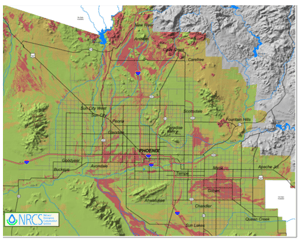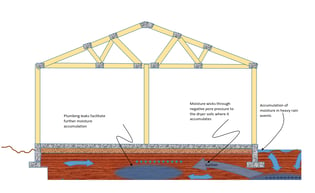Understanding Site Soil Conditions
 The first thing on any foundation Investigation is to assess what the known condition of the soils are. The more sources the better. There are several sources to consider.
The first thing on any foundation Investigation is to assess what the known condition of the soils are. The more sources the better. There are several sources to consider.
The investigator will look around the site and observe. Are there sidewalks on site that show signs of heaving? Are the soils exhibiting signs of clay shrinking?
One thing I like to do is to get a sample of soil from a few feet below the surface. Add water and roll it into a cigar if it rolls up without falling apart then it is clay.
One of the primary sources of information is the National Soil Conservation Resource survey. This is a fairly accurate map of known soil conditions. It usually gives information on a specific depth. A sample pic is above Usually the top 5 feet from the surface.
The link to the map is: http://www.azgs.az.gov/files/phoenix-expansive-soils-nrcs144p2_064581.pdf
You can also access this for Phoenix at: https://www.foundationrepairsaz.com/soil-moisture-management.html
Tucson at: https://www.foundationrepairtucson.com/soil-moisture-management.html
Bear in mind that this is not the end all of all soil information. For example, in Litchfield Park they have tremendous soil problems, yet comes up green on the map, because the original clays were deeper than 5 feet. Much of the upper soils were removed during development.
If there are soil reports on the specific site that is the best information however most times that info is not available. Sometimes reports from nearby sites can be useful.
It helps to be familiar with the geography in the area. Historical aerial photos can sometimes show if the site was once a river bed or if the site was filled. One site that we came across showed how the site was filled with trees, and then covered up with more fill! Knowing how various clays and other soils are deposited also helps understand the site. That is a whole geology course on its own.
Once you understand the soil layer compositions, you can use this information to understand if the site has more of a potential for heave or settlement.
Next: Rules of Thumb III: https://www.foundationaz.com/blog/rules-of-thumb-diagnosing-foundation-problems-part-iii
Previous: Rules of Thumb I: https://www.foundationaz.com/blog/rules-of-thumb-diagnosing-foundation-problems-part-i
____________________________________________________________________________________________________
To schedule your free initial foundation repair consultation, call (602) 470-1311






